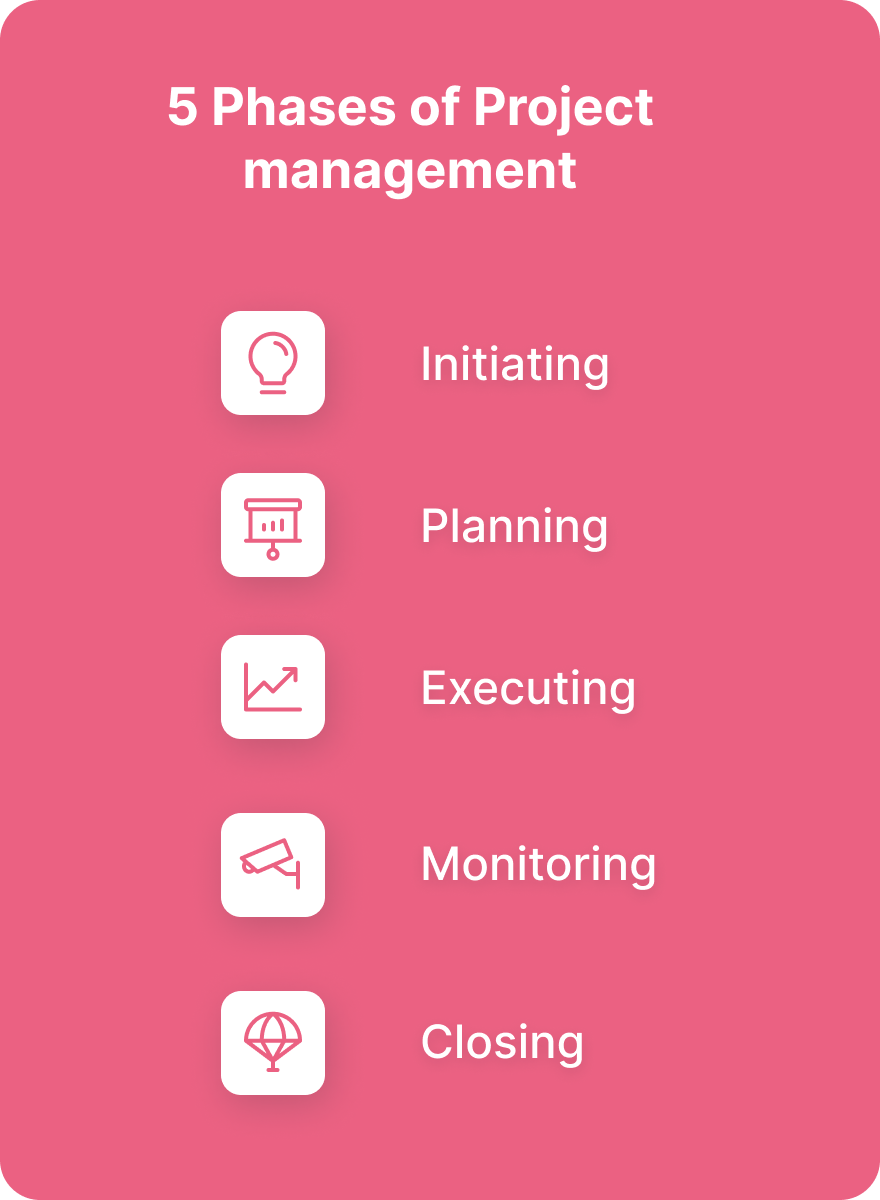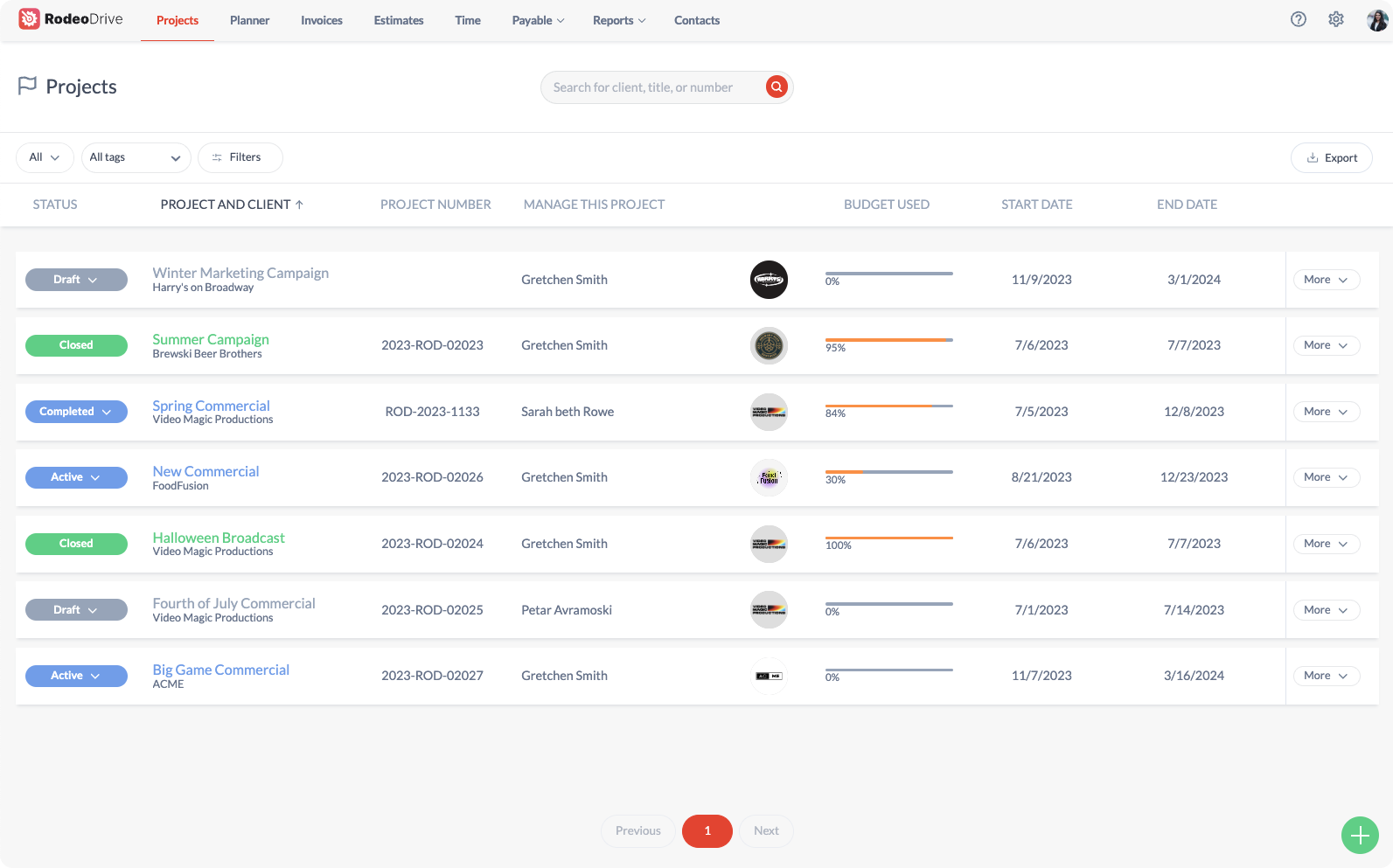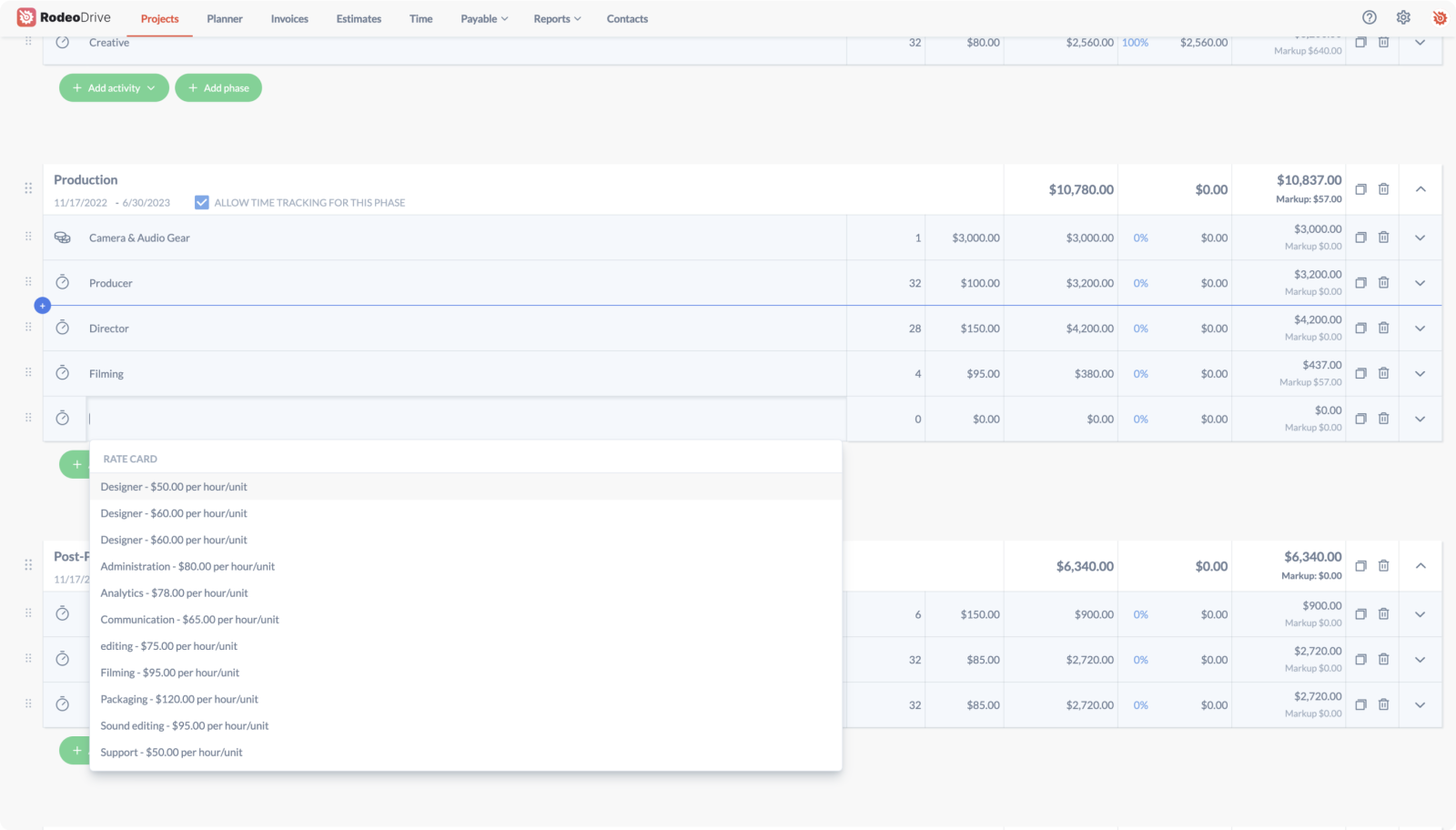What is Project Management? A 2024 View
Project management is a term that gets thrown around a lot these days, but few people actually understand what it is.
This confusion is understandable given that project management has many different phases, roles, definitions, and methodologies that contribute to a complete understanding of the term.
But don’t worry – we’re here to break down everything you need to know about project management, including current industry trends we’re beginning to see for 2024.
By the end of this article, you should have a better understanding of project management to help you decide if it’s something you should try implementing yourself.
What is a project?
Projects are defined as a sequence of activities that must be completed in order to achieve certain goals or objectives or solve a problem the company is currently facing. A project is typically comprised of tasks, activities, and deliverables that must be executed to achieve an outcome or output.
This is different from regular organizational activities because projects are temporary and operate within a set budget and timeframe and adhere to requirements outlined by clients or stakeholders. Once the project objectives are completed, the project is over.
While this might sound like a foreign concept, you’re likely already working on projects in your professional and personal life. A work project might be something like building a website, developing a new product, or creating a report. A personal project would be something like remodeling your home.
All of these projects have a defined timeline, goal, and scope while requiring resources and some degree of management – all of which are typical project characteristics.

So, what is project management?
Project management is defined by the Project Management Institute as “the use of specific knowledge, skills, tools, and techniques to deliver something of value to people.” In simpler terms, project management is when you deliver upon a set of objectives within a defined budget and time frame.
Every project involves several different components, including proper project planning, documentation, task tracking, and communication. The goal is to use all of these processes to successfully complete the expected deliverables within the constraints provided by the client or other stakeholders.
All projects undergo five phases, which are sometimes referred to as the project life cycle.
Related: How to Write a Persuasive Project Proposal

The five project management phases are as follows:
- Initiating: This is when you lay the groundwork for your project by conducting research and understanding the timeline, budget, and deliverables your stakeholders expect you to adhere to.
- Planning: This is the phase in which you decide how your project team is going to complete the work. Planning typically includes finalizing your timeline, budget, and methodology you’ll use.
- Executing: The execution phase is when the team actually gets to work. Project managers shift from planner to manager during this phase, and team members work to meet the necessary milestones and produce high-quality outputs.
- Monitoring/controlling: Project monitoring involves closely tracking the project to ensure that it’s progressing in line with the expected project timeline. Bottlenecks that are forcing the project to veer off course should be identified and remedied in this phase.
- Closing: This final step involves presenting the project deliverables to the client or stakeholders once the project objectives have been met.
Whereas regular management is ongoing, project management is constrained to its own timeline. The two are related though, as project managers provide the leadership and motivation needed for teams to be successful. They also act as a resource to help team members overcome roadblocks – similar to the role of a manager in a regular office environment.
Also read: The Project Management Checklist: 12 Steps to Follow
Now, you might be wondering: why is project management important? According to the Project Management Institute, 25 million new project management employees are needed by 2030 in order to meet global talent demands worldwide. It’s critical to have a clear understanding of project management and how it works if you’re trying to break into the industry – which currently boasts 2.3 million annual job openings.
The role of project managers
Project managers are the ones in charge of leading projects and ensuring the team is on track for success. They prevent projects from failing by devising detailed plans, managing communication, overseeing timelines, and preventing scope creep.
Every project manager is in charge of making strategic decisions that support the project’s goals. It’s their job to hold team members accountable and ensure that the team is producing work of the highest quality.
Project managers are typically responsible for the following tasks:
- Selecting and implementing project management methodologies
- Defining project scope
- Managing client or shareholder expectations
- Project administration
- Planning project stages
- Allocating resources
- Estimating timelines and project costs
- Managing team capacity
- Assigning tasks
- Balancing project risks
- Facilitating team collaboration and regular meetings
- Ensuring deliverables are high-quality before they’re presented to stakeholders
Not everyone has what it takes to be an effective project manager. Project managers must be good communicators, highly organized, skilled in creative problem-solving, and self-motivated.
Project managers exist in every type of organization in every industry, whether it’s construction, non-profits, or startups. Although the role of a project manager can vary, the general skills required remain the same.
Most of these skills are developed through experience, and earning a four-year degree as well as certifications like the Certified Associate in Project Management (CAPM) are great ways to bolster your skill set. That said, there are many ways to become a project manager.
Also read: Product Manager vs. Project Manager: Understanding the Differences
When and why should you use project management?
Every organization engaging in project-based work will find project management beneficial.
As discussed above, projects are temporary activities that must be undertaken to achieve a particular goal, with a constrained timeline or budget. Project management helps teams manage their progress, time, and resources more effectively.
Even organizations that only occasionally work on projects should still implement project management whenever possible. For example, a company that’s rebranding might find it easier to carry out the rebrand using a project framework or project management tool.
Although larger companies with bigger projects might have more resources to hire a certified project manager, companies of all sizes can use project management. There are numerous project management software tools on the market that can provide planning, monitoring, and reporting assistance that can guide teams lacking an experienced PM.
After all, every company has work that needs to be done. Why not give it a try and see if proper project management can help your team better manage their resources?
Read also: Performance Reporting Tools for Project Management
The benefits of project management
Projects very rarely go perfectly and according to plan. There will inevitably be bumps in the road, and project management is what allows teams to adapt quickly and prevent those roadblocks from derailing their progress.
Project management has dozens of benefits, but here’s a look at the top six advantages:
Keeps projects organized
Disorganized projects often have important items slip through the cracks, which can create large problems later on in the project management process. Instead, because project management involves a phase that’s entirely dedicated to strategic planning, project managers are always clear on exactly when and why each project activity needs to occur.
Additionally, project managers serve as dedicated leaders whose job is to manage project logistics, meaning team members don’t need to be worried about the overall project’s organization. Keeping projects organized is much simpler when just one person is in charge of planning and logistics.
Improves teamwork and productivity
As they say, teamwork makes the dream work, and proper project management is key in facilitating team collaboration and productivity.
Proper project planning involves creating a project team with the right skill sets and availability to accomplish project goals. By assigning team members to project tasks aligned with their expertise, project managers can help their teams become more successful and productive.
Selecting a team with skills that complement each other can make all the difference in improving the quality of the team’s work. Sometimes this involves using cross-functional collaboration to your team's advantage.
Workload management also plays a role in project management, and being able to distribute tasks according to availability is a big upside of project management. Visual methodologies like the Kanban method help prevent too many tasks from falling onto one person. After all, the last thing you want is for employees to underperform because they’re under too much pressure.
Project managers can also help the team function better by acting as a middleman with the power to change timelines, resolve disputes, or communicate with the client as necessary. This allows project team members to focus on their tasks at hand and get more done.
Happier teams and delighted clients
When a project results in high-quality deliverables, clients are sure to be satisfied with your team’s work. Project management helps ensure that the team produces outputs that the client will be satisfied with and that are delivered on time and within budget.
Plus, projects free of team conflict and miscommunication make team members happier and more productive. Who wouldn’t want that?
Check out our complete guide on client management for ways to help your team build strong relationships with customers.
Helps teams stay on schedule
Even the most poorly managed projects will likely have some sort of timeline, but whether that timeline is realistic is an entirely different story.
Project management ensures that timelines are achievable and that there are the necessary structures in place to adjust project timelines as necessary.
Some project management methodologies are specifically made to create realistic timelines, such as the critical path method. By outlining all tasks and their associated dependencies and estimating how long each will take to complete right at the very beginning of the project, the project manager gains a realistic estimate of the time needed to complete the project.

Related: What is a Gantt Chart? Guide for Beginners
Boosts accountability
Project management keeps projects organized and on a set timeline. Since everyone has set tasks and responsibilities with clear deadlines, it’s much easier to hold team members accountable and develop a culture of self-accountability.
PM tools with reporting features are another great resource for fostering accountability. That's because project management reports can provide insights into employee productivity, the amount of time tracked, and data on the financial health of the project.
.png)
Rodeo Drive’s time report, which displays all hours your team has recorded
Better resource management
Improper resource management can have severe consequences for a project. A resource misallocation that causes the project to go over budget can leave stakeholders dissatisfied with your work. Project management ensures that you build a strong budget right from the get-go, which is the first step in a project’s success.
Many project managers will create a resource management plan prior to kicking off the project, which usually outlines things like employee bandwidth, the tools at the team’s disposal, and specifics on how the budget will be allocated.
While it’s important to plan your resource allocation, it’s perhaps more important that you follow through with it. One of the phases of project management is monitoring, which is a step that ensures you’re using your resources efficiently.
For example, if a team member is taking twice as long as expected to complete their assigned tasks, then the number of billable hours recorded will far exceed the estimated number. This discrepancy could be a sign that adjustments need to be made. Project management makes it easier to identify this type of issue and respond accordingly.
Improves team communication and collaboration
Poor communication can cause misalignment among team members. To prevent this, project managers often build a project communication management plan as part of the planning phase, which should include a schedule for regular communication and set expectations for how often meetings and updates will occur.
Better communication also allows for more feedback opportunities. For example, during regular check-in meetings, team members can share what the project manager can do differently to help them achieve their goals.
Higher quality deliverables
Many projects fall victim to scope creep, which is when unanticipated changes are made to the project requirements or scope. Scope creep can impact the project deliverables, and bumps in the road – as well as scope creep – can cause project outputs to stray from expectations.
The good news is, project management methods help teams properly manage changes to objectives and deliverables made during the project. For example, scrum teams reflect on their progress after each sprint, which provides a built-in structure that helps them adapt to changes and findings along the way.
Every project will include numerous tasks and subtasks to manage, but project managers ensure that teams never lose sight of the bigger picture. Part of their job also includes proofreading and ensuring all work is of the highest quality before it is presented to stakeholders.

Retain valuable knowledge for next time
Regardless if a project succeeds or fails – there are always lessons to be learned. However, failure to properly retain those learnings can cause that knowledge to be lost. This is why it’s important to have team meetings to reflect and document what worked and what didn’t so that changes can be made for next time.
Project management helps facilitate knowledge storage, as part of a project manager’s job is to retain and apply the knowledge they accumulate from each project. Seasoned project managers typically have a robust understanding of best practices and which methodology works best for each type of project, which makes them valuable resources for the project team.
Investing in a project management software tool, like Rodeo Drive, is another way to retain learnings from past projects. With Rodeo Drive, you’ll have all of your historical data from past projects accessible in a centralized place, ready to be referred back to if necessary.

Rodeo Drive’s Projects page, which provides an overview of upcoming, current, and past projects
This means that if the project team, upper management, or project stakeholders ask you how much certain activities usually cost, you’ll quickly have answers with the data to support your claims. After all, learning from past mistakes is extremely important in ensuring the success of future projects.
5 methodologies for project management
Finding the right project management methodology to use as a framework for your project can be difficult. There are quite literally thousands of different project management methodologies to choose from due to the fact that project management has so many different use cases.
Some methodologies even require certification. For example, the PMI offers an Agile Certified Practitioner (ACP) certification that verifies a project manager’s knowledge of Agile principles, skills, and techniques. The ACP certification process includes an exam with questions on scrum, Kanban, and lean methodologies.
Project management certifications aren’t always necessary, but project managers who are certified certainly might have an edge over those who are not, at least in the eyes of stakeholders who are looking for a qualified PM to lead an important project.
But even though there are so many methodology options, most projects follow the most popular methods – many of which don’t require any certification to implement. Here’s a general overview of five of the most popular approaches to project management:
- Critical path method: CPM helps project managers create accurate project schedules using task mapping to determine the minimum amount of time needed to complete a project.
- Agile project management: The agile method revolves around sprints, which are short cycles of work that allow teams to iterate upon their project plan along the way rather than following a rigid sequential plan.
- Kanban project management: Kanban is a visual methodology where tasks are added to a board with columns representing each project stage. Tasks move through the board as they progress, which helps keep all team members on the same page.
- Waterfall project management: The waterfall method is a traditional and straightforward approach wherein a linear project plan is created based on project requirements and is then executed.
- Scrum project management: Scrum is a highly flexible agile method with specified team roles – such as the scrum master and product owner – that help oversee team sprints and manage progress.
The methodology that will work best for you as a project manager will depend on your industry and objectives. Project management is never one-size-fits-all.
For example, agile methodologies are popular among software development teams that require flexibility throughout the project life cycle, whereas teams in construction may find that the waterfall approach works best since the cost of materials makes it difficult to return to a previous project stage once that stage is completed.
Here are more details on each approach:
Critical Path
The critical path method is a way of determining the minimum time required to complete a project based on a visual map of task sequences.
To make use of the critical path project management methodology, create a list of all project tasks and their dependencies and estimate how long each will take. Once you’ve done so, your longest sequence of critical project tasks can be identified as your critical path, which is what establishes your entire project timeline.
Since your critical path sets the pace of the entire project, you’ll know how to prevent delays on this path in order to avoid derailing your entire project timeline.
Agile
The agile method is known for its flexibility and collaborative nature that allows project teams to iterate on the project while working on it rather than following a concrete plan that’s linear and can’t be changed.
Because agile project management utilizes short phases of work – called sprints – it’s extremely easy to make data-driven adjustments to the project as it progresses based on testing results. This makes it a good approach for teams whose objectives are liable to change and for teams prioritizing speed over perfection.
Kanban
The Kanban methodology is one of the most visual ways to help your team keep track of a project’s progress – making it a popular choice among marketing agencies and creative project teams.
Also read: How to Create a Winning Marketing Project Plan
Kanban boards are broken up into columns where each column represents a different project stage. Tasks move between the columns as they’re completed, which allows for at-a-glance status updates. The visual nature of this method makes it easy to manage team workloads and identify where bottlenecks are forming in your workflows.
Typically, project managers will keep a backlog of tasks and add them to the board as team capacity increases during the project. The backlog helps limit multitasking by allowing each team member to work on a smaller number of tasks at a time.
Looking for more details on creative project management? Check out our ultimate guide for 2024.
Waterfall
The waterfall method is the most traditional project management framework, and as such, it’s typically what comes to mind when most people think of project management.
This methodology takes a linear approach where project managers create a sequential project plan based on the project requirements and objectives. This usually means that each stage of the project must be fully completed before the next one begins, and you can’t go back to a previous stage.
Similar to a waterfall, progress only flows in one direction under this method. This makes it a good fit for projects where the goals and scope are set in stone and aren’t going to change, such as construction or manufacturing.
Scrum
Scrum is a type of agile methodology wherein teams of no more than 10 people work in short cycles called ‘sprints’ that typically last 1 to 2 weeks. A leader known as a ‘scrum master’ oversees team progress during sprints and conducts daily scrum meetings to make sure the project is on track.
In addition to the scrum master, the methodology also requires there to be a product owner on the team, which is someone who’s responsible for representing the client or stakeholder’s best interests and has the final say on the product.
Scrum is a highly flexible method, and as such, at the end of every sprint, the team participates in a performance review to gain insight into what changes are necessary to improve performance on the next sprint. This flexibility makes it a popular choice among software development teams.
What does project management look like in 2024?
Project management has certainly evolved and changed over the last few years, especially in the wake of the pandemic. More teams are working in a hybrid or entirely remote environment than ever before.
In recent years, American workers have also been experiencing a productivity decline, meaning they’re working more hours but are producing fewer outputs. However, the business sector’s productivity was actually up by 4.7% in the third quarter of 2023 — a meaningful increase considering productivity was down by 4.1% in the second quarter of 2022, according to the U.S. Bureau of Labor Statistics.
What’s accounting for this increase in productivity? Well, it’s hard to identify just one root cause. But looking forward to 2024 project management trends, AI is front and center, and it certainly has tremendous benefits for increasing productivity.
Many project managers have begun using tools like ChatGPT to take mundane tasks off their plates. In fact, 81% of people in project management feel as though AI is already impacting their organization.
This will certainly be a trend that continues well into 2024, in addition to an increased reliance on automation within project managers’ day-to-day workflows. After all, project teams can get far more completed with the help of these new tools.
Use Rodeo Drive to automate and optimize your project management process
Not every team has the budget for a certified project manager, which is why a project management software solution can be a lifesaver to help you save money and get more done.
Allow us to introduce you to Rodeo Drive: an all-in-one project management software tool that helps optimize your workflows and improve team productivity. Plus, any project-based team can use a tool like Rodeo Drive, even if you don’t consider yourself a “project manager.”
Rodeo Drive’s key feature offerings include:
- Budgeting: Create phase-based budgets that help you ensure you’re correctly pricing your projects.
- Estimating: Easily send preliminary budgets to your client as an estimate for them to approve — directly from Rodeo Drive.
- Time tracking: Ensure your team’s billable hours are properly tracked with Rodeo Drive’s live timer or timecard function.
- Planning: Better manage your team’s workload capacity by assigning activities with Rodeo Drive’s timeline-view planner.
- Invoicing: Bill your clients for your hours worked directly from Rodeo Drive (UK) or via QuickBooks (US).
- Reporting: Monitor your team’s usage of the platform with automatically generated reports on their productivity and time registration, in addition to your projects report, which highlights the financial health of your projects.
Now that we’ve covered the basic capabilities, let’s do a deep dive into the features that help Rodeo Drive stand out among its competitors:
Phase-based budgeting that provides you with real-time status updates
We believe successful projects begin with a budget, which is why you’ll be prompted to build a budget when you create a new project in Rodeo Drive. Project budgets in Rodeo Drive are broken down into phases, activities, and tasks – so building your budget will also help guide you through the planning process.
For example, a video production studio might break its project budgets into pre-production, production, and post-production phases – each of which will include activities and tasks under each phase.
When adding a task to a phase, you can estimate how long it will take to complete, and based on the rate cards you’ve entered, your budget will be automatically calculated. At a glance, you’ll be able to see how much each phase will cost and what activities are included in each phase.

Creating a phased budget in Rodeo Drive
As your team tracks time in Rodeo Drive, your budget will update to reflect the percentage of your budget that you’ve already spent. This helps easily prevent overspending. Time tracking is easy – simply start the live timer on your Planner before you get to work or add a timecard for work you’ve already completed.

Adding a new billable hours timecard in Rodeo Drive
Generate detailed reports on profitability and employee productivity
Reports are an invaluable feature to have in project management software. They allow you to monitor progress, easily keep clients informed, and help you make data-driven decisions when planning or pivoting, which contributes to project success.
.png)
Projects report in Rodeo Drive
Rodeo Drive’s reporting feature provides detailed reports on time registration, employee productivity, and project profitability. These insights can make workload management easier and help you have a better understanding of what tasks are eating up your budget.
Get started with Rodeo Drive for free – no credit card required.
Takeaway
Well, there you have it. We hope we’ve successfully answered all of your questions about project management – what it is, who it’s for, and how you can begin to implement it using a software tool.
If you’re looking for an all-in-one project management solution to serve as a single source of truth for your projects, don’t forget to check out Rodeo Drive. With budgeting, task planning, and financial management features all in one place, Rodeo Drive helps companies of any size manage their projects more efficiently to save time and valuable resources.
Come try Rodeo Drive for yourself and sign up for free.








